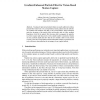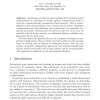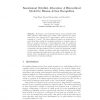HUMO
2007
Springer
14 years 4 months ago
2007
Springer
Tracking of rigid and articulated objects is usually addressed within a particle filter framework or by correspondence based gradient descent methods. We combine both methods, suc...
HUMO
2007
Springer
14 years 7 months ago
2007
Springer
We propose a method to find candidate 2D articulated model configurations by searching for locally optimal configurations under a weak but computationally manageable fitness functi...
HUMO
2007
Springer
14 years 7 months ago
2007
Springer
In this paper, we present a 3D registration algorithm based on simulated physical force/moment for articulated human motion tracking. Provided with sparsely reconstructed 3D human ...
HUMO
2007
Springer
14 years 9 months ago
2007
Springer
Tree-structured models have been widely used for human pose estimation, in either 2D or 3D. While such models allow efficient learning and inference, they fail to capture additiona...
HUMO
2007
Springer
14 years 9 months ago
2007
Springer
We propose a new method for human action recognition from video sequences using latent topic models. Video sequences are represented by a novel “bag-of-words” representation, w...
HUMO
2007
Springer
14 years 9 months ago
2007
Springer
We present a method to simultaneously estimate 3d body pose and action categories from monocular video sequences. Our approach learns a lowdimensional embedding of the pose manifol...
HUMO
2007
Springer
14 years 9 months ago
2007
Springer
Abstract. Learned, activity-specific motion models are useful for human pose and motion estimation. Nevertheless, while the use of activityspecific models simplifies monocular t...
HUMO
2007
Springer
14 years 9 months ago
2007
Springer
This work presents a marker-less motion capture system that incorporates an approach to smoothly adapt a generic model mesh to the individual shape of a tracked person. This is don...
HUMO
2007
Springer
14 years 9 months ago
2007
Springer
We describe a “bag-of-rectangles” method for representing and recognizing human actions in videos. In this method, each human pose in an action sequence is represented by orien...
HUMO
2007
Springer
14 years 9 months ago
2007
Springer
This paper presents a solution to the problem of tracking people within crowded scenes. The aim is to maintain individual object identity through a crowded scene which contains com...



